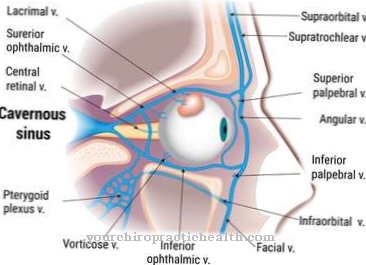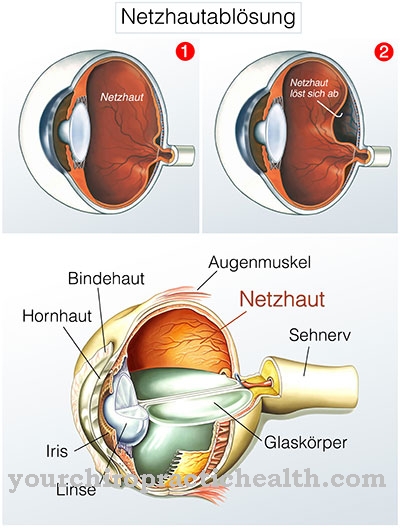In the Hyperoxaluria there is an increased excretion of oxalic acid in the urine. The oxalic acid precipitates with calcium to form the poorly soluble calcium oxalate and leads to the formation of calculus in the kidneys. The disease can cause kidney failure and systemic impairment of various tissues.
What is hyperoxaluria?

© gritsalak– stock.adobe.com
The Hyperoxaluria is a serious condition characterized by an increased excretion of oxalic acid in the urine. Oxalic acid is a metabolic end product that is normally rapidly broken down into carbon dioxide and water. However, if this breakdown does not work properly or if too much oxalic acid enters the organism through food, poorly soluble calcium oxalates can form with calcium, which can settle as urinary stones in the urinary organs.
This especially damages the kidneys. There are both primary and secondary forms of hyperoxaluria. Primary hyperoxalurias are always genetic and can be divided into three types. In all three types there are enzyme defects which lead to increased oxalic acid formation or to reduced oxalic acid breakdown in the organism. The oxalic acid must be excreted in the urine.
It combines with calcium to form calcium oxalate, which crystallizes in the kidneys and partly in other organs. Secondary hyperoxaluria is often associated with other metabolic diseases that lead to increased calcium concentrations in the blood. It is also caused by an increased intake of foods containing oxalic acid.
causes
The primary hyperoxalurias are genetic defects. Primary hyperoxaluria of type I is an autosomal recessive metabolic disease, which is characterized by a defect in the liver enzyme glyoxylate aminotransferase. The enzyme is responsible for converting glyoxylate into glycine.
When this enzyme is inoperable, glyoxylate accumulates, which is then broken down into oxalic acid. The oxalic acid concentration is also increased in primary hyperoxaluria of type II (PH II). The enzyme glyoxylate reductase / hydroxypyruvate reductase is defective here. As a result, oxalate accumulates because glyoxylate can no longer be converted.
In PH III, the enzyme 2-keto-4-hydroxy-glutarate aldolase is inoperable, which also leads to an increased oxalic acid concentration. The oxalic acid must be excreted with the urine. At very high oxalic acid concentrations, however, it precipitates as the calcium salt and forms urinary stones in the kidneys. The constant deposition of calcium oxalate causes kidney inflammation and scarring reactions that eventually affect the functioning of the kidneys.
Systemic oxalosis also occurs. In the course of oxalosis, precipitates of calcium oxalate form in many other organs, as the oxalic acid concentration in the blood is increased. Vascular walls, eyes, heart muscle, skin, bones or the central nervous system are affected. This results in typical impairments of the affected organs such as blindness, bone oxalosis, cardiac arrhythmias or anemia.
Organ failure even threatens death. The secondary forms of hyperoxaluria are often based on other metabolic diseases that are associated with an increased release of calcium. Calcium then binds more intensely with existing oxalic acid to form oxalates, which in turn can precipitate.
This occurs, among other things, with hyperparathyroidism, Cushing's disease, sarcoid, [[bone metastases]), multiple myeloma or with an overdose of vitamin D. Secondary hyperoxaluria can also develop if there is an excessive intake of oxalic acid through food. There is a particularly large amount of oxalic acid in rhubarb, sorrel, spinach and cocoa products.
Symptoms, ailments & signs
The symptoms of hyperoxaluria can be varied. Even with the same form, the course of the disease can vary greatly in the individual affected. The increased concentration of oxalates in the urine is typical. Usually stone formation occurs in the urinary organs.
In primary hyperoxaluria, the formation of oxalates in the kidneys and other organs can be so massive that considerable kidney and other tissue damage occurs even in childhood. Other people with primary hyperoxaluria may only develop occasional kidney stones as they get older. Overall, symptoms occur that are characterized by severe kidney dysfunction, urinary stone formation, renal colic, hematuria, fever and kidney failure.
When the kidneys stop working effectively, the levels of oxalate in the blood also rise, which can lead to the formation of oxalosis in various tissues. Cardiac arrhythmias, high blood pressure, partial tissue necrosis (gangrene) and restricted mobility of the joints then occur.
Diagnosis & course of disease
The diagnosis of hyperoxaluria is made by measuring the oxalic acid concentration in the urine. The oxalic acid excretion should not exceed 40 milligrams per day.
Complications
Most patients experience kidney problems due to hyperoxaluria. Other tissues in the patient's body can also be affected by the disease. This leads to increased stone formation in the kidneys and thus to considerable pain for the patient. The tissue on the kidneys and other organs can be severely damaged by hyperoxaluria, so that limitations of these organs may be expected.
Most patients also suffer from a fever and a general feeling of illness. In the worst case scenario, complete kidney failure can occur if the hyperoxaluria is not treated early by a doctor. Furthermore, high blood pressure occurs, which in the worst case can lead to a heart attack. Untreated hyperoxaluria leads to a reduced life expectancy.
Acute emergencies can usually be treated with high fluid intake. In severe cases, however, various organs must be transplanted to the patient. Under certain circumstances, this can lead to complications or other complaints. However, these depend on the precise circumstances of the disease and cannot be generally predicted.
When should you go to the doctor?
If symptoms and complaints such as urinary stones, kidney colic or fever are noticed, the cause may be hyperoxaluria. A doctor should be consulted if the symptoms persist for more than two to three days. Should further symptoms appear in the course, such as signs of hematuria or kidney dysfunction, the family doctor must be consulted immediately. A visit to the hospital is indicated in the event of serious complications such as cardiac arrhythmias or tissue necrosis.
In severe cases, the emergency doctor should be called immediately. This is especially true if the symptoms appear suddenly and are associated with symptoms of failure. In this case, it is best to seek medical advice immediately. People who have been found to have such genetic defects are particularly prone to developing hyperoxaluria. Likewise people with Cushing's disease, sarcoidosis or hyperparathyroidism. If you belong to these risk groups, it is best to see a doctor immediately with the symptoms mentioned. In addition to the family doctor, a specialist in internal medicine or a nephrologist can be called in.
Doctors & therapists in your area
Treatment & Therapy
Hyperoxaluria is first treated with increased fluid intake. In addition, inhibitors are administered that prevent the formation of crystals of calcium oxalate. These include magnesium, citrate and bicarbonate, among others. The urine is kept as alkaline as possible to keep calcium oxalate in solution.
In patients who are very sensitive to vitamin B6, pyridoxine is substituted in order to reduce the production of oxalate. These treatments can delay the course of severe primary hyperoxaluria. In many cases, however, a combined kidney-liver transplant is necessary even in childhood to prevent the enzyme-related oxalate formation and to save the patient's life.
Outlook & forecast
The prognosis for hyperoxaluria is very different. If left untreated, it can be very severe. Type I primary hyperoxaluria has a particularly poor prognosis. Like the other two primary forms of the disease, it is genetic. Secondary hyperoxaluria is based on another disease.
However, what all hyperoxalurias have in common is the deposition of calcium oxalate in the organism. Due to the high degree of saturation with calcium oxalate in the urine, the crystals precipitate, especially in the kidneys, and over time cause severe kidney dysfunction. The oxalates appear as kidney stones that constantly damage the kidney tissue. The disease can also be mild into old age, with only isolated kidney stones being diagnosed again and again. In other cases, such as primary type I hyperoxaluria, severe kidney damage occurs in early childhood. If left untreated, hyperoxaluria is often fatal.
Oxalosis (deposition of oxalate crystals) often spreads to the entire organism as the kidneys become increasingly restricted. The heart muscle, blood vessels, eyes, skin, bones and central nervous system are often affected. As a result, complications such as cardiac arrhythmias, blindness, untreatable anemia, vascular diseases or oxalate bone diseases occur. Some of the diseases are fatal. In many cases, even intensive therapy with high fluid intake and drug-based inhibition of crystal formation can only delay the course of the disease, but not prevent it. Sometimes a combined liver-kidney transplant is required.
prevention
Prevention of primary hyperoxaluria is not possible because it is genetic. Foods containing oxalic acid should be avoided if predisposed. Overall, the consumption of very large quantities of rhubarb, spinach or products containing cocoa should be restricted, as these can possibly lead to secondary hyperoxaluria.
Aftercare
In the case of hyperoxaluria, the person concerned is primarily dependent on a quick diagnosis and subsequent treatment in order to prevent further complications and complaints from this disease. The earlier a doctor is consulted, the better the further course of this disease is usually. The person affected should therefore contact a doctor as soon as the first symptoms and signs of hyperoxaluria appear, as in the worst case it can also lead to death.
Self-healing cannot occur in this disease, so treatment is always necessary. The follow-up measures are limited. In most cases, hyperoxaluria is treated with the help of medication. It is important to ensure the correct dosage and regular intake.
Especially with children, parents need to check the correct intake and dosage. In the event of side effects or interactions, a doctor should be contacted first. Furthermore, regular examinations of the internal organs are very important in order to determine damage to the internal organs and treat them in good time. Therefore, the life expectancy of the person affected may also be limited or significantly reduced by the hyperoxaluria.
You can do that yourself
In most cases, the symptoms can be avoided relatively easily by changing your diet. However, early detection of the disease also has a very positive effect on the course and can prevent discomfort and damage to the kidneys.
As a rule, the person affected should avoid foods containing oxalic acid with hyperoxaluria. The consumption of products containing cocoa should also be restricted as far as possible. Furthermore, the person affected must avoid spinach or rhubarb in their diet. In most cases, hyperoxaluria does not represent a major restriction in everyday life or in the patient's food intake. By taking pyridoxine, those affected can reduce the oxalate in the body. It is only necessary to ensure that it is taken regularly so that there are no further complaints.
The acute symptoms of the disease are mostly treated by increasing the intake of fluids. Because the disease can also damage the kidneys or heart, people should have regular checkups. In the case of psychological complaints or depression, discussions with other sufferers of hyperoxaluria or with close confidants and their parents often help.






.jpg)






.jpg)

.jpg)
.jpg)











.jpg)